Symmetry Analysis and Wave Solutions of Time Fractional Kupershmidt Equation
Abstract
This study employs the Lie symmetry technique to explore the symmetry features of the time fractional Kupershmidt equation. Specifically, we use the Lie symmetry technique to derive the symmetry generators for this equation, which incorporates a conformal fractional derivative. We use the symmetry generators to transform the fractional partial differential equation into a fractional ordinary differential equation, thereby simplifying the analysis. The obtained reduced equation is of fourth order nonlinear ordinary differential equation. To find the wave solutions, F/G-expansion process has been used to obatin different types of solutions of the time-fractional Kuperschmidt equation. The obtained wave solutions are hyperbolic and trigonometric in nature. We then use Maple software to visually depict these wave solutions for specific parameter values, providing insights into the behaviour of the system under investigation. Peak and kink wave solutions are achieved for the given problem.
1. Introduction
Different forms of Kupershmidt equations exist and some of them are the following:
Studying problems like the Kupershmidt equation is important in many domains, including nonlinear optics, fluid dynamics, and plasma physics, where nonlinear dispersive waves play a key role.
The Kupershmidt equation has been the focus of various investigations in recent decades. Researchers have looked at several elements of this equation, including its characteristics, analytical solutions, numerical techniques for solving it, and applications in a variety of domains. Mustafa used the Adomian decomposition method (ADM) [5] to analyze the soliton solutions of the KK problem. The Cole–Hopf transformation and simplified Hirota’s approach [6] were used to solve the generalized Kaup–Kupershmidt problem. Atangana and Goufu [7] expanded the nonlinear Kaup–Kupershmidt to fractional calculus by utilizing the conventional Caputo derivative and the recently created Caputo–Fabrizio derivative, which has fractional order and no singular kernel. Several fixed-point theorem techniques, as well as the concept of Piccard L-stability, were used in the analysis to show the existence and uniqueness of the precise solution to models with both types of derivatives. Finally, several numerical simulation methodologies for both nonlinear models and graphical simulations for values of order 1.00 to 0.90 were given. The solutions were shown to behave similarly to the well-known conventional travelling wave solution for the Kaup–Kupershmidt issue. Also, Chauhan and Arora [8] used the Lie symmetry technique to generate symmetry generators for the time fractional Kupershmidt equation, using the Riemann–Liouville fractional derivative.
The bilinear technique was used to generate multisoliton solutions to the generalized fifth-order KK problem [9]. The velocity of the soliton was found to be related to the sign of the physical parameters. Iqbal et.al. [10] employed an iterative transformation strategy to provide analytical solutions, and applied an iterative transformation to provide analytical solutions for fractional-order KK equations. In 2022, three examples of the time-fractional Kaup–Kupershmidt equation were explored using the decomposition technique [11] for two types of fractional derivatives. The resulting results were compared to the solutions produced by other approaches. To analyze the solution behaviour of fuzzy-fractional–Kaup–Kupershmidt equations in both uncertain and crisp situations, a novel generalized semianalytical technique, namely, the homotopy analysis general integral transform, was used [12].
Podder et.al [13] studied the space-time fractional nonlinear evolution equation using the Bernoulli subequation function approach, and 2d and 3d plots were drawn for expressing the wave solutions. The space-time fractional CD and PKP equations [14] were solved using the G′/G and 1/G-expansion methods to achieve the closed form wave solutions. The space-time telegraph equation and KdV equation [15] were studied using the Tanh method using conformal fractional derivatives by Arefin et al. Khatun et al [16] studied the partial differential equation (PDE), namely, the couple Boussinesq equation using the Sine–Gordan expansion method to find the wave solution using wave transformation for converting FPDE to ODE and obtained solutions were illustrated using 3d plotting. The space-time Cahn–Allen and Benjamin–Bonamahony equations [17] were solved through the extended Tanh-function method in the sense of Atangana beta derivatives. Uddin solved the space-time–modified KdV and Sine–Gordan equation [18] using a generalized G′/G-expansion approach in order to obtain the kink wave, bell type, and periodic type solutions.
Cevikel [19] examined the Duffing equation in order to use the conformable Duffing model to discover the travelling wave solutions. With the aid of conformable fractional derivatives, nonlinear fractional differential equations were precisely solved using the modified simple equation approach [20]. Moreover, Cevikel researched the nonlinear YTSF [21] equation in order to determine the precise solutions by several methods. Conformable fractional derivatives were used to study the fractional Fitzhugh–Nagumo equation, the fractional Newell–Whitehead–Segel (NWS) equation, and the fractional Zeldovich equation in order to determine their precise solutions [22].
All the models which have the diffusion form are expressed in equilibrium stages, and the diffusion model which contains different terms can also be studied in subdiffusion stages in fractional form. Many mathematicians define fractional differential equations over time in order to represent the subdiffusion states of the system through the use of fractional derivatives. There are several ways to define these fractional derivatives, including Riemann Liouville, Caputo, and Riesz. However, one form that is utilized for solving fractional equations is the conformal derivative form.
According to the previous literature, this equation is not studied in conformable fractional form to find the wave solutions by using Lie symmetry analysis, which reduces the fractional PDEs into ordinary differential equations.
The time fractional Kupershmidt equation, given in Equation (5), is a special case of the fifth-order KdV–mKdV equation and is called the generalized Kupershmidt equation. Here, is the conformal fractional derivative [23], u represents the wave amplitude in space x w.r.t. time t, and a, b, and β are undetermined constants. This PDE includes both dispersion and nonlinear effect, that is, uxxx indicated third order dispersion, whereas refers to nonlinear effect. We use the Lie symmetry technique to explore the symmetry features of the time fractional Kupershmidt equation given in Equation (5) and derive the symmetry generators, which incorporate a conformal fractional derivative. We also use the F/G-expansion process as a means of generating wave solutions to the problem. We then use Maple software to visually depict these wave solutions for specific parameter values, providing insights into the behaviour of the system under investigation.
The novelty of the work is that the Lie symmetry has been applied in the Riemann–Liouville form for reduction of the Kupershmidt equation, but solutions were not obtained; but in conformal form, after applying the Lie theory, solutions have been obtained by using F/G expansion method. We then use Maple software to visually depict these wave solutions for specific parameter values, providing insights into the behaviour of the system under investigation.
This paper is constructed in the following manner: Section 2 consists of the Lie symmetry technique. Section 3 covers symmetry reductions [23]. Section 4 explains the approach for identifying wave solutions. Section 5 employs the F/G-expansion method to create travelling wave solutions. Section 6 contains three-dimensional graphs of wave solutions. The essay ends with the conclusion.
2. Lie Symmetry Technique
And , where extended infinitesimal associated with the conformable fractional time derivative of differentiable functions.
3. Symmetry Analysis and Reduction
- i.
τx = 0, τu = 0,
- ii.
ξu = 0,
- iii.
ηuu = 0,
- iv.
−aη − auξx − 3ηxu + 3ξxx − βξx = 0,
- v.
−aηu − aξx = 0,
- vi.
−2bβuξx − 2aηx + auξxx + ξxxx − 2βηxu − 3ηxxu − bβη + βξxx − t1−αξt + aηuu2 − 2auηxu − 3ξxau2 − 2auη + au2ξx − au2ηu = 0,
- vii.
τt−α − t1−ατt − ταt−α + t1−αηu = 0,
- viii.
4. F/G-Expansion Method
Step 1. By introducing the variable ξ = x − tα/α, assume that
The wave variable ξ transforms Equation (18) to ODE.
Step 2. Suppose that the solution of ODE Equation (20) can be expressed by a polynomial in F/G as follows:
In cooperation with Equation (22), the following listed solutions to F(ξ) and G(ξ) can be discovered.
Case 1. If λ > 0 and μ > 0, then the following hyperbolic function solutions of Equation (22) are as follows:
Case 2. If λ < 0 and μ < 0, then the following hyperbolic function solutions of Equation (22) are as follows:
Case 3. If λ > 0 and μ < 0, then the following trigonometric function solutions of Equation (22) are as follows:
Case 4. If λ < 0 and μ > 0, then the following trigonometric function solutions of Equation (22) are as follows:
Step 3. Using Equation (21) and Equation (22) in Equation (20) severally produces a set of algebraic equations for (F/G)q(q = 1, 2, ⋯, w). By equating the coefficients of (F/G)q to zero, a set of nonlinear algebraic equations in vq(q = 0, 1, 2, ⋯, w) is obtained. On solving these algebraic equations by Maple, numerous exact solutions of Equation (18) for Equations (19), (21), (23), (24), (25), and (26) will be achieved.
5. Traveling Wave Solutions
Case 1. When
- a.
If λ > 0 and μ > 0, then the following hyperbolic function solutions are obtained:
In specific, if , , we have the solitary wave solution
- b.
If λ < 0 and μ < 0, then the following hyperbolic function solutions are obtained:
In specific, if , , we have the solitary wave solution
- c.
If λ > 0 and μ < 0, then the following trigonometric function solutions are obtained:
- d.
If λ < 0 and μ > 0, then the following trigonometric function solutions are obtained:
Case 2. When
- a.
If λ > 0 and μ > 0, then the following hyperbolic function solutions are obtained:
In specific, if , , we have the solitary wave solution
- b.
If λ < 0 and μ < 0, then the following hyperbolic function solutions are obtained:
In specific, if , , we have the solitary wave solution
- c.
If λ > 0 and μ < 0, then the following trigonometric function solutions are obtained:
- d.
If λ < 0 and μ > 0, then the following trigonometric function solutions are obtained:
Case 3. When
- a.
If λ > 0 and μ > 0, then the following hyperbolic function solutions are obtained:
In specific, if , , we have the solitary wave solution
- b.
If λ < 0 and μ < 0, then the following hyperbolic function solutions are obtained:
In specific, if , , we have the solitary wave solution
- c.
If λ > 0 and μ < 0, then the following trigonometric function solutions are obtained:
- d.
If λ < 0 and μ > 0, then the following trigonometric function solutions are obtained:
Case 4. When
- a.
If λ > 0 and μ > 0, then the following hyperbolic function solutions are obtained:
In specific, if , , we have the solitary wave solution.
- b.
If λ < 0 and μ < 0, then the following hyperbolic function solutions are obtained:
In specific, if , , we have the solitary wave solution
- c.
If λ > 0 and μ < 0, then the following trigonometric function solutions are obtained:
- d.
If λ < 0 and μ > 0, then the following trigonometric function solutions are obtained:
6. Comparison Study
- i.
The generalized Kupershmidt equation was solved by Salas [6] using the Cole–Hope transformation, and hyperbolic function solutions were obtained.
- ii.
KK equation was also solved by improved G’/G-expansion [29] and extended G′/G-expansion method using local fractional derivative. The obtained results are exponential, hyperbolic, and trigonometric.
- iii.
Rezazadeh et al. [30] used subequation method to obtain the exact solutions of time fractional Kaup−Kupershmidt equation using conformal fractional derivative. Trigonometric and hyperbolic function solutions are obtained.
7. Discussions
- i.
Figure 1 shows the solution given in Equation (34) with paramteric values .
- ii.
Figure 2 shows the solution given in Equation (36) with parametric values .
- iii.
Figure 3 shows the solution given in Equation (37) with parametric values .
- iv.
Figure 4 shows the solution given in Equation (38) with parametric values .
- v.
Figure 5 shows the solution given in Equation (40) with parametric values .
- vi.
Figure 6 shows the solution given in Equation (42) with parametric values .
- vii.
Figure 7 shows the solution given in Equation (43) with parametric values .
- viii.
Figure 8 shows the solution given in Equation (44) with parametric values .
- ix.
Figure 9 shows the solution given in Equation (46) with parametric values .
- x.
Figure 10 shows the solution given in Equation (48) with parametric values .
- xi.
Figure 11 shows the solution given in Equation (49) with parametric values .
- xii.
Figure 12 shows the solution given in Equation (50) with parametric values .
- xiii.
Figure 13 shows the solution given in Equation (52) with parametric values .
- xiv.
Figure 14 shows the solution given in Equation (54) with parametric values , x = −10 ⋯ 10, t = 0 ⋯ 100.
- xv.
Figure 15 shows the solution given in Equation (55) with parametric values .
- xvi.
Figure 16 shows the solution given in Equation (56) with parametric values .
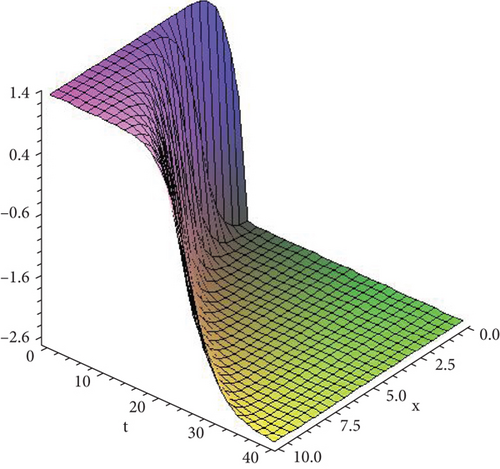
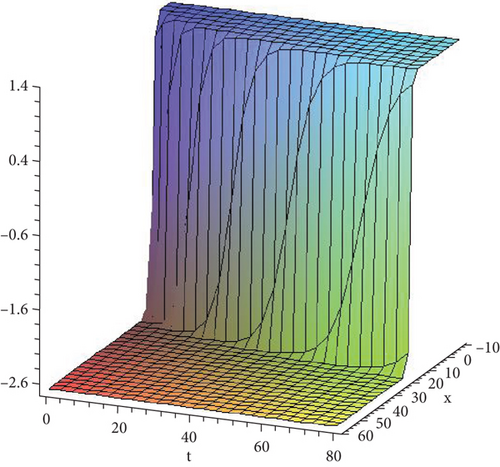
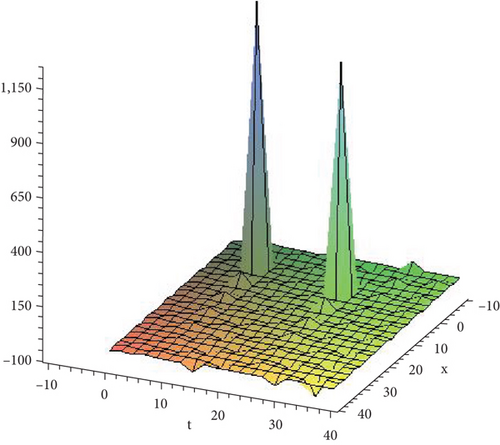

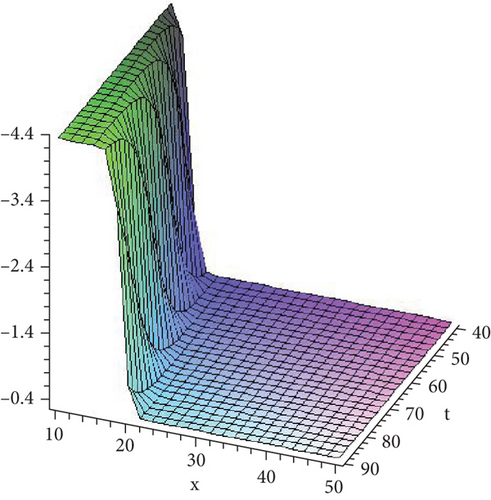


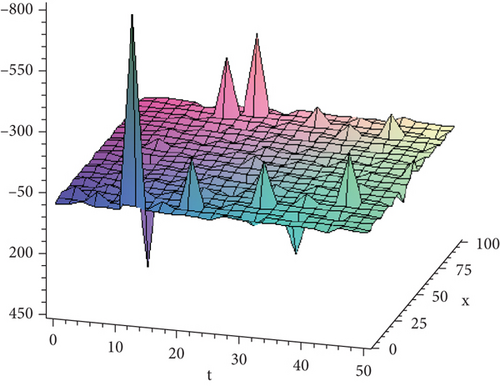
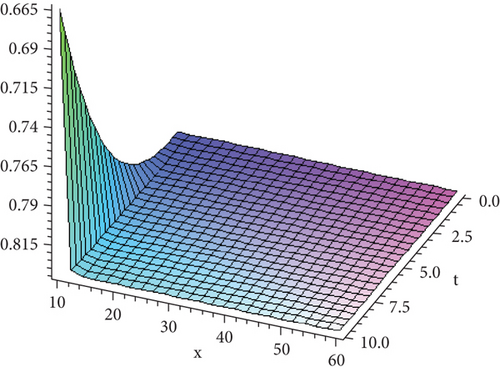
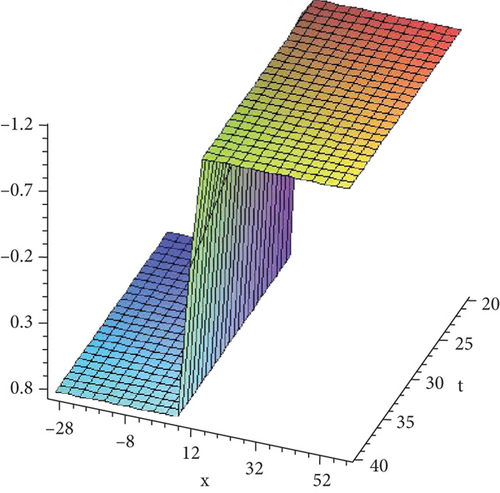

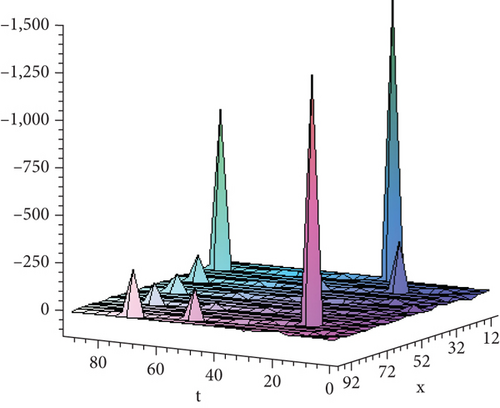
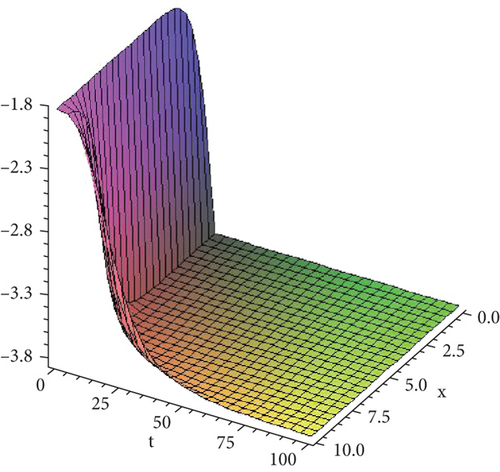
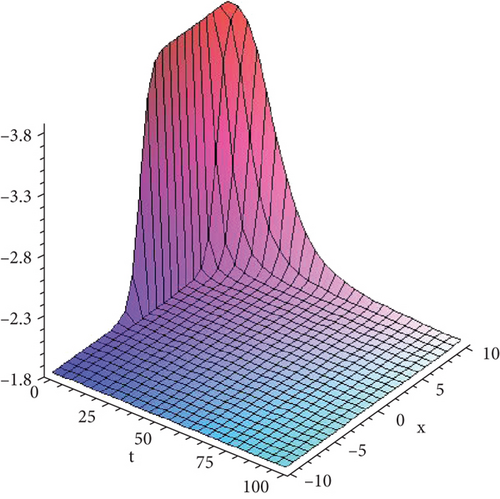
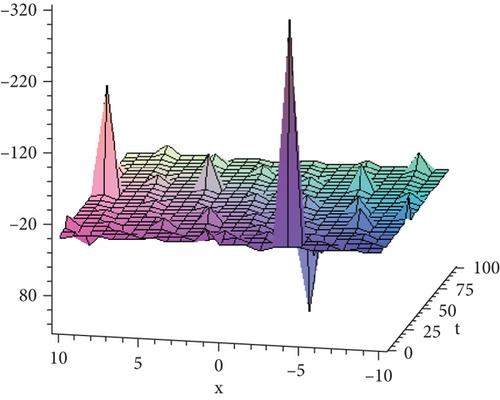
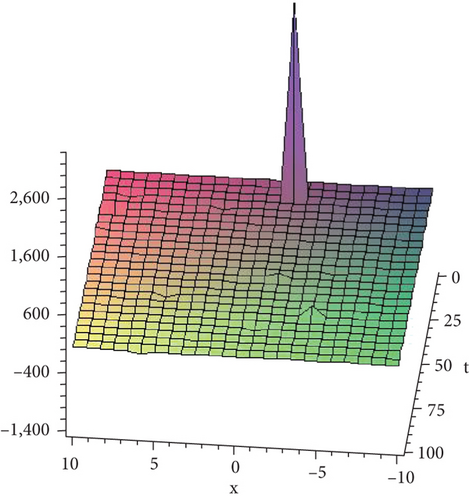
8. Conclusion
This study successfully used the fractional Lie symmetry technique to analyze the similarities between the time fractional Kupershmidt equation and the conformal fractional derivative. We have reduced the fractional PDE to the fractional ordinary differential equation via symmetry reductions. Only wave solutions exist for the reduced ordinary differential equation. The approach of F/G-expansion was applied to get more precise and general solutions to nonlinear evolution equations. In addition to producing extra travelling wave solutions with a variety of physical structures, the F/G-expansion technique also produced hyperbolic and trigonometric functions as solutions. Several travelling waves and soliton-like solutions that were previously recognised are revealed by our findings. Obtained solutions were compared to the solutions obtained by other researchers. Furthermore, as compared to current technology, the proposed solution may greatly reduce the amount of computational work. In order to give further context for each solution, graphs were also created, and peak wave and kink wave plots were produced.
Conflicts of Interest
The authors declare no conflicts of interest.
Funding
The authors received no specific funding for this work.
Open Research
Data Availability Statement
The data that support the findings of this study are available on request from the corresponding author.




